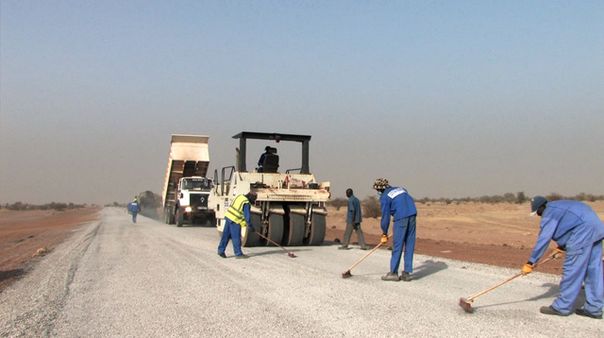Road to Nowhere
Road-building can be tough, but the uncertain destination makes it even worse, as detailed in the Berlinale Forum documentary HABITER/CONSTRUIRE.

Clémence Ancelin's HABITER/CONSTRUIRE
Sometimes it’s uncertain if Berlinale Forum’s HABITER/CONSTRUIRE (LIVING/BUILDING, France) is a real film or simply scrapped footage. The documentary, about the effects of a new asphalt road near Oum Hadjer, Chad, is more monotonous than watching paint dry, though watching paint in a dry climate like Chad would take less time than this 117-minute long film.
All walks of life are represented in LIVING/BUILDING as villagers, nomads and road workers form a loose, disjointed band to support the creation of the road. Director Clémence Ancelin interviews people from each group to paint a comprehensive picture of the road works, and occasionally these subjects provide illuminating detail about their everyday lives.
One of the few interesting contrasts is the living conditions of the African service workers who live in cramped, make-shift huts, versus those available to the French expat employees who live comfortably in brick buildings. For a project organised by a French company, it’s not surprising that only the white folks get luxuries like constant and varied food provisions, including rarities like fish (a detail even the French interviewee finds baffling, given their desert location).
Low production values and poorly considered framing and composition make scenes without dialogue, information or any action painful to watch. Unfortunately, such scenes are abundant. At least there is some effort put into editing, including multiple montages of interior objects in the homes of the interviewees. But even these sequences feel flat and empty, and you begin to question the necessity of Ancelin going trigger happy on inanimate objects like fluorescent bulbs.
One of the few memorable scenes is a group of Africans building a straw roof. The complexity of the weaving and knotting of straw and millet, and the workers’ shouts as they communicate on either side of the roof feel more human and real than the majority of interviewees who are speaking directly to the camera.
Scenes of hard labour are a gold standard in social documentary because they open a window into the real day-to-day minutiae of subjects, whose lives are rarely seen outside the inquisitive lens of the documentary filmmaker (some of the most creative examples were in much earlier days of documentaries, including John Grierson’s DRIFTERS and the GPO Film Unit’s LISTEN TO BRITAIN and NIGHT MAIL).
On the other hand, even this strategy can backfire when the camera focuses on machinery instead of human activity. In another scene in LIVING/BUILDING, a crane moves huge boulders. There is absolutely nothing interesting to see here, though perhaps even a shot of the construction worker’s fingers could have helped. Instead, we are forced to wonder what the rocks really mean in the greater scheme of the Chad road works. In LIVING/BUILDING, our questions are always left unanswered, with the biggest one being: where does the road lead?


301 Moved Permanently